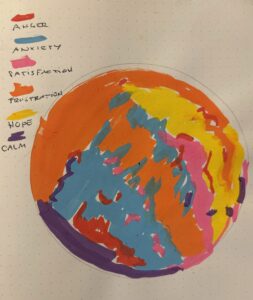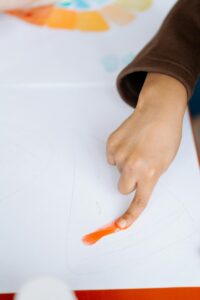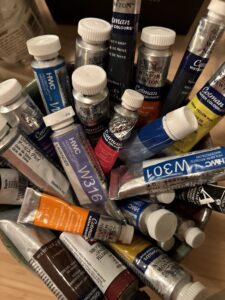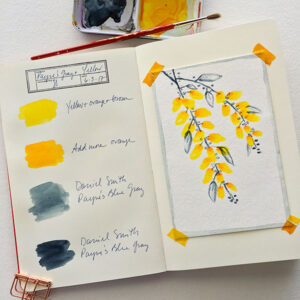
Remember when you were very young and you colored with crayons and felt delight at seeing the color on the page? Maybe some of you were told to stay inside the lines, and that felt like no fun. Maybe scribbling is what felt free and wild and like something magical. And for others, seeing the black outline around their color felt satisfying, like a statement, almost like an exclamation point.
 For many, as adults, the idea of creating art brings up resistance. Thoughts like, “I’m not creative,” “I can’t draw,” or “I can only make stick figures” become barriers to even trying. But what if creativity isn’t about skill or talent? What if we made it about exploration, play, and self-expression like when we were young?
For many, as adults, the idea of creating art brings up resistance. Thoughts like, “I’m not creative,” “I can’t draw,” or “I can only make stick figures” become barriers to even trying. But what if creativity isn’t about skill or talent? What if we made it about exploration, play, and self-expression like when we were young?
Art has the power to heal, not because of the final product, but because of the process itself. When we allow ourselves to create freely, without expectations, we tap into a deeper part of ourselves—a space of self-discovery, release, and renewal.
This blog will guide you through simple ways to use art as a tool for healing, helping you open your mind to creativity, embrace playfulness, and connect with your emotions in a way that words often cannot.
Open the Door to Creativity
Before we begin, I want you to visualize something. Close your eyes if you’d like. Imagine a giant whiteboard in front of you, covered in words—phrases you’ve told yourself over the years about why you can’t create. Maybe it says:
- I’m not artistic
- I don’t know how to draw
- I always mess up when I try to make art
- I’m too old to learn something new
- I’m not as good as so and so…(fill in the blank)
Now, visualize yourself picking up a large eraser and wiping those words away. One by one, clear the board, until all that remains is a clean, white surface.
Next, take a marker and write new words on the board:
- I am open to learning new things
- I am open to trying
- I am open to exploring
- I am open to seeing what happens without expectations of perfection
- I am open to playing with color and shape
Take a deep breath and sit with that feeling. Then, open your eyes and remember what it felt like to be a child, to create just for the joy of it. Think back to when you used to make messy inhibited art like finger painting or mud pies without worrying about whether it was “good.”
Hold onto that memory as you embark on this journey—not to create something perfect, but simply to enjoy the act of making.
Create a Judgment-Free Art Journal
One of the most freeing things you can do is dedicate a space solely for playful creation. This is where an art journal comes in.
This journal is not for sharing. It’s not for showing off. It’s not meant to be a masterpiece. Think of it like a notepad for scribbling down thoughts—you don’t expect every note you jot down to become a published book. It’s just a space to explore.
Choose an inexpensive sketchbook or notebook, one that feels approachable rather than too precious. When we buy expensive materials, we often hesitate to use them, fearing we might “mess them up.” But creativity should be explorative, messy, imperfect, and fun. Let this journal be a place for play, curiosity, and expression—no pressure, no judgment.
Keep Art Supplies Accessible
 One of the biggest barriers to creativity is simply not having materials readily available. If you have to dig through a closet to find your supplies, chances are, you won’t use them often.
One of the biggest barriers to creativity is simply not having materials readily available. If you have to dig through a closet to find your supplies, chances are, you won’t use them often.
Make creativity easy. Keep pencils, markers, and paper in a visible, accessible place—perhaps in a big cup on your dining table or desk. If you enjoy painting, set up a small area where you can keep your paints handy. The easier it is to reach for your materials, the more likely you are to use them.
Consider integrating short creative moments into your daily routine:
- Morning coffee doodles: Spend 10–15 minutes drawing as you sip your coffee
- Lunchtime sketches: Take a break to doodle something simple
- Weekend art sessions: Dedicate 30 minutes to an hour for a relaxed, playful art session
The key is to let creativity become a natural, effortless part of your day.
Embracing Doodling as a Simple and Playful Practice
Doodling is often dismissed as mindless scribbling, but in reality, it’s a powerful tool for relaxation and creativity.
Here are some fun ways to start:
- Crumple a piece of paper, flatten it out, and color in the shapes formed by the creases
- Sketch everyday objects, like your coffee mug, a croissant on your plate, a flower from your walk
- Look at objects differently. Instead of thinking, “I’m drawing a flower,” break it down into simple shapes: ovals, triangles, and lines
- Try drawing something upside down. This encourages you to look at shapes instead of what the object is
- Create overlapping circles, then color in the new shapes formed where they intersect
The goal is not precision or realism—it’s exploration. When you let go of expectations, creativity becomes a freeing and joyful experience. Now check out what you made! Every line made is your creation, and nobody else’s. Unique, just like your fingerprint, just like you.
Exploring Emotions Through Color
Art is a powerful way to express emotions, often revealing feelings we might not even be consciously aware of.
One simple practice is painting your emotions:
- Choose colors that resonate with how you’re feeling in the moment
- Use freeform strokes and movements to express that emotion
- Let the process guide you rather than trying to create a specific image
Another method is the Emotion Circle Exercise:
- Draw a large circle on your journal page
- Select a color that matches how you feel and begin filling in the circle
- If you’re feeling energetic, you might use a bold orange and fill in a large portion. If you’re feeling calm, you might add soft blue strokes in one section
- Don’t structure it like a pie chart—let it be organic, flowing, and intuitive
 Seeing emotions mapped out in color rather than words helps shift the way we process them. It moves us from the analytical left brain to the intuitive right brain, allowing for a deeper, subconscious exploration of feelings.
Seeing emotions mapped out in color rather than words helps shift the way we process them. It moves us from the analytical left brain to the intuitive right brain, allowing for a deeper, subconscious exploration of feelings.
Observing the World with an Artist’s Eye
Creativity isn’t just about making—it’s also about seeing.
Start looking at the world around you with more awareness:
- Notice how light and shadow change throughout the day
- Observe the subtle variations in color in nature
- Pay attention to shapes and patterns in everyday objects
Have you ever looked at a tree to see how many different shades of green there are? Deep blue greens within the shadows, pale yellow greens, vibrant greens in varying tones. Once you start to observe shadows and light within objects, you begin to view color through an artist’s eye. This is a big step in observation.
Keep a section in your journal for visual notes—quick sketches, color swatches, or descriptions of things you find interesting. This practice trains your brain to notice beauty in the ordinary, deepening your appreciation for the world around you. These notes are just for you. You don’t need to worry about making it an archive of your artistic observations, just capture your thoughts.
The Healing Power of Creativity
Remember this: Tapping into your creative side isn’t about becoming an artist—it’s about reconnecting with yourself. Say it again.
When you create freely, without pressure or judgment, you allow space for self-expression, emotional release, and self-discovery. Art becomes a way to process emotions, shift perspectives, and engage with the world in a more mindful way.
And the best part? You don’t need any formal training or special skills. Creativity is already within you—all you have to do is allow yourself to welcome it.
Do this for yourself! Grab a journal, pick up a pen, pencil, whatever you like, and begin! Not to create something perfect, but simply to explore. To discover. To create. To reconnect with a part of yourself that has always been there, waiting patiently to come out and play.










No comments yet.